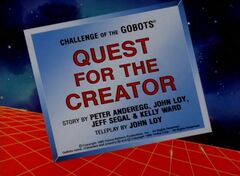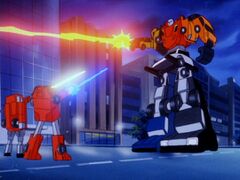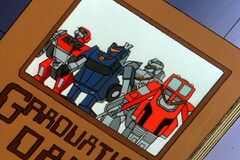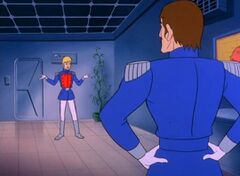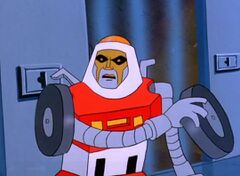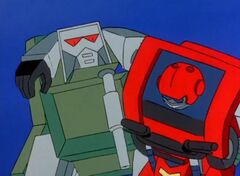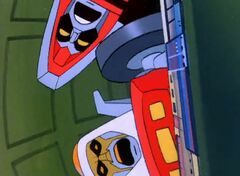Challenge of the GoBots/Continuity
Challenge of the GoBots has a lot of problems with continuity. Like, a lot a lot.
Context[edit | edit source]
American cartoons of the eighties were generally not made to be shown in any particular order. Between the pressures of production requiring interchangeability, the extensive use of freelancing writers who largely worked alone rather than part of a writing team and the episodes needing to be comprehensible to an impressionable kid when they randomly start watching episode 37 there's not much scope for tight overall plotting. In some ways it is a miracle some shows of the period hold together as well as they do. As such the episodes were largely written by professional "journeyman" writers who cared little beyond meeting their deadlines in a competent enough fashion to get their pay and next commission. Writing cartoons for a licenced property did not pay particularly well and brought little in the way of long-term royalties. Ironically, it is the writers who moved away from the "device of the week" hack formula and tried to do something a little more ambitious that cause the headaches. Like The Transformers, Challenge of the GoBots has a handful of multi-part stories that could be sorted out in time to ensure they aired in order and a bunch of simple self-contained episodes. Aside from that, the show was built to be watched by small kids and sell them toys, not to be analysed by bigger kids some 35 years later - plot arcs and even character development were not the aim of the exercise.
Issues[edit | edit source]
Unlike The Transformers, there doesn't seem to have been anyone particularly watching episode to episode continuity. This should have been the job of story editors Jeff Segal and Kelly Ward; while the pressures and demands of creating a show on a limited budget, a tight schedule and pressure from Tonka to feature their latest wares can't be underestimated it's hard to argue that the pair did a good job. It would seem that the pressures of having to produce a 60-episode TV series on a tight budget and hectic schedule with a toy manufacturer as a partner overwhelmed any particular plans for episode-to-episode continuity. That said Segal and Ward did themselves few favours, spreading themselves thin by contributing substantially to no less than 39 of the 60 "regular" episodes - conversely their Transformers equivalents Dick Robbins and Bryce Malek made only four credited appearances on the same number of episodes. According to comments from at least one Challenge of the GoBots writer (Michael Hill) the contributions of Segal and Ward were not always solicited either.
Format[edit | edit source]
The Challenge of the GoBots cast centred around a group of regulars who were in nearly every episode - Leader-1, Turbo, Scooter, Cy-Kill, Crasher, Cop-Tur, Matt, A.J. and Nick. To sell more toys, both factions were typically joined by one or two guests. These were seemingly picked at random, likely as a balance of fitting in with the needs of the script and making sure as many of the toys as possible were featured. Adding to this was that the GoBots toyline was evolving as the cartoon was produced, something illustrated by the occasional use of early working names and colour schemes for some characters. There do seem to have been some attempts at a more structured approach. In addition to the five-part GoBotron Saga, several episodes serve as expository "soft" introductions for some characters and concepts, though these are rarely explicit.
Continuity[edit | edit source]
For whatever reason the lack of a strong overseeing hand meant problems when characters outside the main cast appeared. Some are quirks common to other shows of the ilk, and relatively benign - for example, however many times Scooter uses his holo-projector to escape from or otherwise fool the Renegades they never cotton on to his ability. In a similar vein, much like the plans of the Decepticons or Cobra, Renegade schemes and devices often come close to succeeding only to be undone by bad luck or some other freak occurrence, rather than a failure of the technology, and yet the following episode Cy-Kill will start his next scheme with a fresh sheet of paper instead of working out what else he can use personal Stealth Devices or Puzzlers for. In the same vein, if a Renegade invention is destroyed it stays destroyed rather than another one being built.
However, other quirks are more troublesome, such as the interchangeable way the show treats characters outside of the regular cast. A good illustrative case is Staks' appearance in the episode "Guardian Academy". For whatever reason, the Super GoBots figure Staks was put alongside the newer characters Tri-Trak, Twister and Tork as a trainee Guardian. He is consistently shown as part of the Blue Team of trainees, is named on a screen, and graduates successfully from the Academy, being put through the Modifier. Within the episode this is 100% consistent.
However, Staks had been shown as an active Guardian since the first mini-series, with the ability to transform to boot. So his appearance as a cadet is completely inconsistent in the wider series. His appearance in "Guardian Academy" is far too substantial to easily dismiss as an animation error, as it is in fact possibly Staks' most substantial showing in terms of screen time. An energetic fan could maybe come up with excuses if so inclined - maybe Staks was hit by the Transgressor during "The Fall of GoBotron" and needed retraining - but that would be fanon at best. As far as the episodes go, Staks is both an experienced converting Guardian and a novice cadet, a state of affairs that makes in-universe writing on the series a tricky affair.
While Staks is perhaps the most visible error of this sort, many others are thrown up by the show's airing order - Courageous and the Monster GoBots show up far ahead of episodes where they are created, Snoop is able to pass as a Guardian despite having previously met Leader-1 et al as a Renegade, Small Foot gets promoted to the Command Center team despite having regularly served with them and so on. Some of these events could be moved around to ease the problems but this certainly wasn't how they were meant to be seen. And moving things around is only possible in some cases; in others, episodes are outright contradictory and cannot be reconciled without an arbitrary declaration that one is "right" and the other "wrong", and then you're firmly in the realm of personal canon.
Format change[edit | edit source]
Between the end of the initial pilot mini-series and the beginning of syndicated episodes the show underwent an off-screen retooling. The mini-series had ended with all the Renegades bar Cy-Kill in custody, the GoBots unknown to the world's wider population and their human friends slipping away in the confusion. Whichever viewing order is used there is a shift in status quo by the next episodes - the Guardians have a firm alliance with UNECOM, who have replaced NASA and NORAD; Matt, A.J. and Nick are back in favour with the authorities; Anya Turgenova is relegated to a guest character with no overt signs of her romance with Matt; the GoBots are public knowledge (allowing for the odd comedic moment of surprise from minor characters) and one way or another the Renegades' situation is changed—including having Roguestar in play. There is no bridge explaining the changes at any point.
The GoBotron Saga[edit | edit source]
The five-part GoBotron Saga is one of the more perplexing and frustrating storylines for continuity issues. It was broadcast just after the midway point of the series' run without any fanfare. It gave origins for both the Monster GoBots and Courageous, both of which had appeared in episodes aired earlier, while there is some dialogue indicating Roguestar, another feature of many episodes, has only just become operational. While it makes perfect logical sense to place it after the first mini-series, it's not a clean fit, adding Cy-Kill to the Renegades captured. It also features UNECOM - and by extension Earth - as firm allies of the Guardians, including sending Matt, A.J. and Nick as ambassadors to oversee the forthcoming Renegade trials and later having a base perfectly made for accommodating a Command Center, while General Newcastle has complete faith in the Guardians being able to retake GoBotron and frustrate the Renegades' plans to invade Earth as well.
However, common sense can sort most of these problems. It is easier to accept that Cy-Kill is captured off-screen and interred on the Prison Moon than that another off-screen escapade saw a large number of Renegades captured separate to the events of "The Final Conflict"; aside from Cy-Kill (and Destroyer) some effort is made by the show to keep those on the Prison Moon consistent with those captured in the mini-series, while the free Renegades seen on Roguestar are characters who had not appeared in those initial five episodes. Similarly there is no set-up elsewhere for the alliance with UNECOM, meaning their introduction in The GoBotron Saga is as good a place for the organisation to debut as any other.
Impossibilities[edit | edit source]
However, whereas many of The Transformers' issues—such as the Combaticons turning up in "Aerial Assault" which was transmitted before their creation in "Starscream's Brigade", can be adjusted easily (though rarely with consensus!), many of the problems with Challenge of the GoBots are, at worst, insoluble when they crop up. As with The Transformers, whether a new character got an origin or not was potluck to some degree—characters such as Small Foot, Heat Seeker, Dr. Go and Bad Boy simply turn up with the vague insinuation they've been in the background somewhere up to this point. However, late in the series' run some genius decided this should change, specifically for the Secret Riders, whose training and graduation from the Guardian Academy were the focus of an episode. While this origin was aired out of order (being the second to last shown) some rejigging solves most of the problems, with one exception. During "Guardian Academy" (again with this episode!), during their training, the Secret Riders to be are attacked by Renegades sent by Cy-Kill—including Creepy. Creepy is just portrayed as another Renegade we've not seen before the same as, say, Stinger. However "Quest for New Earth" features the Secret Riders on what is explicitly their first mission together, which pits them up against the Master Renegade. In this episode Creepy is portrayed as loyal to the Master Renegade and having remained in seclusion on Antares III since the events of The GoBotron Saga and being unknown to Cy-Kill's main body of Renegades (and even staying separate from them at the end of the episode). So whichever way around you choose to watch those episodes there's a huge continuity error—either Creepy is shown working for Cy-Kill, when Cy-Kill has never met him, or the Secret Riders have their first mission before going through graduation and final modification.
In-episode impossibilities also occur. "Et Tu, Cy-Kill" is a flashback to earlier events, showing Cy-Kill leaving the Guardians for the Renegades. So as not to confuse anyone the episode takes the sensible approach of a framing sequence where Scooter tells the story to injured new recruit Tri-Trak and the trio of human regulars. However, Tri-Trak himself appears in the flashbacks—which not only contradicts his origin in "Guardian Academy" but makes even less sense when present-day Tri-Trak reacts with surprise and questions to the events. And that's before you even get to Twister's role in the episode…
In conclusion...[edit | edit source]
It's a bloody mess. Here at GBWiki we use a story order so that in-universe entries make sense, while freely admitting that such a thing can't solve all the show's many problems.
And Transformers fans complain about there being three vague explanations for the Constructicons…
